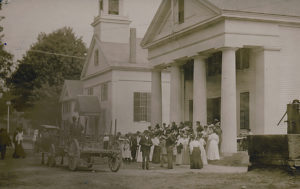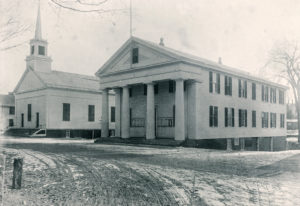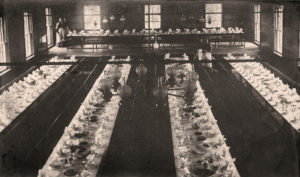I ask myself all the time, “Why do I care so much for our Town Hall?”. It’s a tough question for me to answer and maybe because the answer is personal.

What strikes a chord is to ponder questions like; What if the Town Hall could speak? What would the whispers say? Would it tell us the tales of the men, women and children who walked on its floors, the music that vibrated its walls, the leaders that spoke within the rooms, the sites seen through its windows. Would it echo the voices of people long gone? Would it tell us of the growing pains from modification and modernization? The oldest town building in Sterling, older than any school, church or Inn surely has some stories to tell. Only some of our towns’ homes would remember more. It has witnessed more in its impressive lifetime than we might imagine. What if the Town Hall could speak?
It’s a struggle to chronicle the history and even more challenging to consider some of the wonder surrounding this simple yet grand old building. If we could take a walk through the annals of time and stroll through nearly two centuries of an unfinished legacy, we would find a tale of citizenship and freedom, excitement and charm, purpose and utility and, not unlike our Town, distinction.
Our original Town House, built on donated land in 1801 and the first in Worcester County separating civic from religious matters, was in need of repair and, after three decades of service, was too small to support the needs of the 1,800 inhabitants of Sterling.
In 1834, the people of Sterling voted to build a new Town House. Jacob Conant, who owned the rights to the cellar of the old Town House as well as the surrounding land, was compensated $80 by the Town to give both over to the Town. The original structure was moved down the road a bit – where it still stands to this day and serves as a residence.
In its place, in 1835, a new well-proportioned building, a monument of sorts, designed by local Sterling builder John Springer, was constructed to support the affairs, meetings, cultural events and community gatherings for a developing Town. At a cost of $2,857.85, a two-story, three-bay Greek temple with a grand entrance through four Doric columns hand-crafted by local builder John M. Stevenson erected atop four large granite steps with a Great Hall and gallery now stood proudly at the center of our Town. A young Edwin Conant delivered the dedication before a large crowd that fine November day. It was followed by an evening of celebration and musical entertainment.
Looking back, 1835 was a time of growth and prosperity, yet there was a fervent memory of the fight for Independence and the spirit of Freedom was still very fresh in the minds of the people – as fresh as  our memory of Man walking on the moon. In the town center, there were two churches (a third soon to follow), three taverns, five stores and mills, farming and manufacturing nearby. Horses, cattle and swine were no longer permitted to roam freely in town, but wagons travelled through the streets with regularity. The national debt decreased to zero for the only time in history. Abraham Lincoln was in his first term in the Illinois House of Representatives. The United States consisted of only twenty-four States. Texas, Michigan, Iowa, Colorado and Florida and twenty-one other States had not yet been admitted to the Union. Jacob Conant was Town Treasurer and Town Moderator. The School Committee had such notable members as Osgood, Kilburn, Wilder, Sawyer and Houghton. Edwin Conant, a Harvard Law School graduate and prominent attorney, had just moved his office from Sterling Center to Worcester.
our memory of Man walking on the moon. In the town center, there were two churches (a third soon to follow), three taverns, five stores and mills, farming and manufacturing nearby. Horses, cattle and swine were no longer permitted to roam freely in town, but wagons travelled through the streets with regularity. The national debt decreased to zero for the only time in history. Abraham Lincoln was in his first term in the Illinois House of Representatives. The United States consisted of only twenty-four States. Texas, Michigan, Iowa, Colorado and Florida and twenty-one other States had not yet been admitted to the Union. Jacob Conant was Town Treasurer and Town Moderator. The School Committee had such notable members as Osgood, Kilburn, Wilder, Sawyer and Houghton. Edwin Conant, a Harvard Law School graduate and prominent attorney, had just moved his office from Sterling Center to Worcester.
The Town Hall was a vital gathering place for all Sterling citizens to congregate for civic, political and cultural matters and occasionally, with permission, religious worship.
As the decades past, the Town Center grew considerably. The old Town Hall welcomed the addition of a Grange, Hotel, High School, Library and nearby Almshouse. It hosted all the meetings of the Selectmen, various committees and especially the School Committee overseeing the eleven School Districts carefully positioned around town.
Sadly, in 1891, Edwin Conant died, but he left a sizeable legacy in cash, property and possessions to the Town of Sterling which helped fund many projects. In addition to his 1885 bequest of the Library, he contributed $20,000 to the Sterling High School and more to local churches. His legacy for Sterling was impressive, but as impressive was his appreciation for education. He left his Worcester mansion and $10,000 in cash to the Worcester Natural History Society now known as the Ecotarium on the condition that they give a series of lectures at Sterling to help educate, inform and enlighten. The Selectmen of the day saw fit to continue the Conant Course of Lectures all of which were held at the Town Hall well into the early 20th century.
But change was soon coming to the old Town Hall. It was noted after a Maypole celebration held at the Town Hall May 13, 1892, “The crowded and suffocating conditions of the hall should strongly impress the Town of the necessity of enlarging it with proper ventilation”. It became evident that the Town Hall was again too small for Sterling.
On March 20, 1893, the Town voted to accept a $2,000 donation from Mrs. Jane Kilburn and promised to pay the balance for a considerable addition to the Town Hall. Two additional bays were added along with a stage, timber beams were removed from the Great Hall and replaced by rods with claws. A gallery audience could clearly view the entire length all the way to the stage. It was reported in the Fitchburg Sentinel August 8, 1893 “The Town Hall is fast assuming the long looked proportions. The Selectmen have had a great deal to bear with the grumbling of those who knew nothing about it, but they are coming off with flying colors and the growlers are resting satisfied”.
This 1906 photograph shows the Great Hall just prior to a large banquet. It was taken from the gallery and shows the rods as well as  the impressive gas-light chandeliers (electricity did not come to the Town Hall until 1911).
the impressive gas-light chandeliers (electricity did not come to the Town Hall until 1911).
There is no single destiny for a building. Purpose evolves over time and that is part of the magic of our Town Hall. History will recount that for nearly two centuries, this building has been used for so many different things. Too long ago for anyone to remember are the multitude of events including preaching of the Baptist minister Rev. Grovesner (1837), Grange meetings (1885), Ladies Industrial Society Annual Meeting (1893), Worcester Medical Societies 50th Anniversary (1909), Annual Balls of many organizations like the Young People’s Union (1894), Sterling High School Alumni (1902), High School Graduation (1906), Sterling Hook and Ladder Company (1914), Leominster Sportsman Association (1930), Scoutmasters (1945) and so many others. Concerts by orchestras and quartets, solo performances in whistling, piano and oration. We have only a few photographs of the theatrical performances presented on the stage which still retains the built-in stage lighting. In winter, people would sleigh ride from surrounding towns to attend a concert or a dance at our Town Hall. In the late 30’s and early 40’s there was dancing every Tuesday night with the music of St. Cyr’s Orchestra or the Jones Boys.
And who knows what sorts of people were held in the steel-reinforced jail cell in the basement when the constables of the day took someone into custody?
More recently, some will recall walking to the Town Hall daily for lunch service while attending Butterick School (now the Municipal Building). Many will remember the weekly auctions popular in the 1930’s, 40’s and 50’s. The Red Cross Chapter headquartered at the Town Hall in the mid 40’s. A few may remember attending Catholic Mass in the Great Hall in the late 50’s some years before their church was built.
Many will recall attending an annual Town Meeting, paying their taxes or obtaining their building permits or dog licenses when all Town Offices were housed here.
And we cannot forget the temporary tenants. The Library when renovating the Conant Library, Fire and Police when their new homes were being built, or DPW when they needed a home.
And today, even more have fond memories of the recreational activities as this is the home of the Sterling Recreation Department and host to many classes and programs for all ages. Of note, toddlers (tiny tots) experience their first interactions with other toddlers as they play or listen to music and singing in the morning. Exercise classes with Boot Camp, Yoga, Zumba or Kettlebells. Meetings of the Girl Scouts, Coin Club, Historical Commission. 1835 Town Hall Committee and others.
The Town Hall means different things to different people at different times in their lives. It is part of the fabric of our Town and weaves its way into the memories and lives of people over time. It remains, mostly unchanged, graciously and humbly serving the needs of all the people in our community.
We owe a debt of gratitude to those who built it and must honor the legacy of those who supported it over the years. We must remember those that found inspiration within these walls?
Stay tuned…
